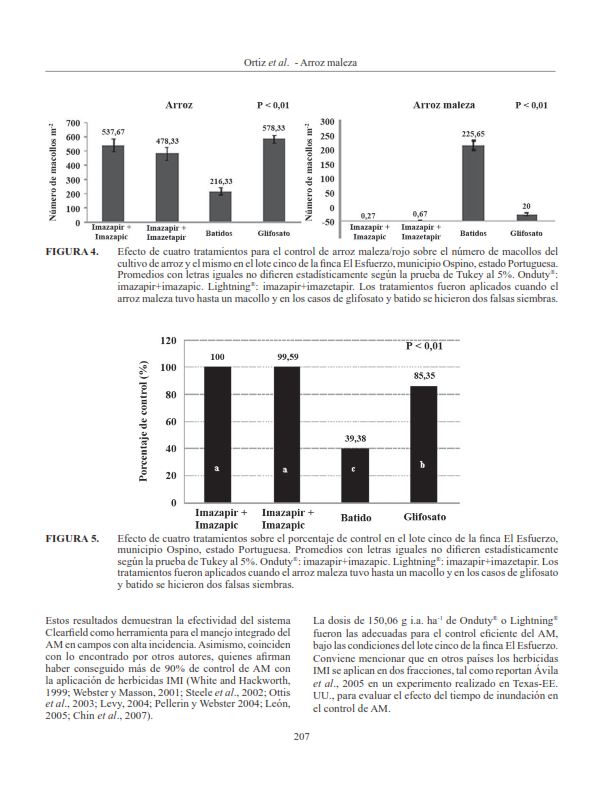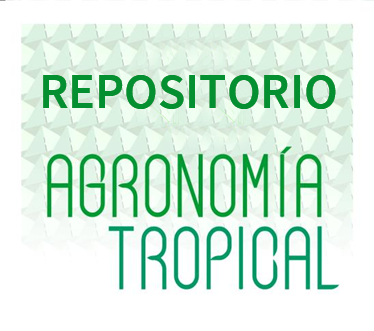Control de arroz maleza
Resumen
El arroz maleza / rojo (AM) causa un gran daño a la cadena de producción de arroz en la agricultura. El objetivo fue evaluar el control del arroz rojo. Se seleccionaron dos campos de arroz bajo riego, altamente infestadas con arroz rojo. Para llevar a cabo esta investigación se establecieron dos experimentos: (1) el control del arroz rojo con tres herbicidas de presiembra: butacloro y oxadiargil se aplicaron en lámina de agua y el glifosato se utilizó en postemergencias en seco en comparación con la preparación del suelo convencional y (2) el control del arroz rojo con glifosato, el encharcamiento del suelo y el Sistema Clearfield (variedad CF-205 + dos herbicidas imidazolinonas: imazapir + imazapic e imazapir imazetapir). Se utilizó la metodología de grandes parcelas con muestreo en ausencia de repeticiones (Machado, 2000). Los resultados revelaron que los rendimientos del arroz en todos los tratamientos de control de AM en presiembra evaluados (batido, glifosato, butacloro y oxadiargil), fueron 40,31; 30,72; 26,48 y 14,17%, mayores que el testigo con AM, respectivamente. Asimismo, el control del AM con estos tratamientos fue superior al 90% cuando se comparó el número de panículas de AM con las halladas en el testigo. Se reporta más de 99% de control del AM en los tratamientos con 150,06 g.i.a.ha-1 de imazapir+imazapic e imazapir+imazatepir; dos falsas siembras con aplicaciones de glifosato 85,35% y batido del suelo 39,38%. Los tratamientos con IMI tuvieron 55,22 y 30,77% más rendimiento que el batido y glifosato.
Descargas
Citas
• Armenta, J. and J. Coulombe. 1993. Highlights of the Caribbean Rice Improvement Network Activities (1986-1992), Bonao, República Dominicana: CRIN/ CIAT/IRRI/IICA/SEA: 53-65 pp.
• Ávila, L., S. Senseman, G. Mccauley, J. Handler and J. O’Barr. 2005. Effect of Flood Timing on Red Rice (Oryza spp.) Control with imazethapyr applied at different dry-seeded rice growth stages. Weed Technology 19:476–480.
• BASF. 2011(a). Kifix. Disponible en: https://on.basf.com/2WGHpOr. [Consultado: agosto 26, 2011).
• BASF. 2011(b). Kifix. Disponible en: https://on.basf.com/2WCh9or. [Consultado: agosto 26, 2011).
• Castillo, J. 2006. Evaluación de la contaminación con arroz rojo en la producción de semillas y granos de arroz en el estado Portuguesa. Trabajo de Grado. Maracay, Ven. Universidad Central de Venezuela. Facultad de Agronomía 90 p.
• Castillo, J., D Gauna y N. Saldain. 2004. II. Estudios para el control de arroz rojo: selectividad del ronstar en Inia Tacuarí y El Paso 144 y su efecto en el control del arroz rojo. INIA TREINTA Y TRES - Estación Experimental del Este Arroz - Resultados Experimentales 2003-04. Uruguay 144-159 pp.
• Català, M. 1995. Chemical and cultural practices for red rice control in rice fields in Ebro Delta (Spain).Crop Protection 14(5):405-408.
• Chin, D., T. Thien, H. Bi1 and N. Nhiem. 2007. Study on weed and weedy rice control by imidazolinone herbicides in Clearfield TM paddy grown by IMI- tolerance indica rice variety. Omonrice 15:63-67.
• Croughan, T. 1994. Herbicide resistant rice. 25th Rice. Technical Working Group Meeting 44 p.
• Croughan, T. H Utomo, D. Sander and M. Braverman. 1996. Herbicide resistant rice offers potential solution to red rice problem. Louisiana Agriculture 39:10-13.
• Croughan, T., J. Baker, R. Dunand and M. Pizzolatto. 1984. Production of commercial rice varieties resistant to herbicides effective over red rice. Ann. Prog. Rept., Rice Exp. Sta., Louisiana Agricultural Experimental Station. Bulletin Nº 76. 67-68 pp.
• Croughan, T., M. Pizzolatto and D. Trump. 1986. Tissue culture production of commercial rice varieties resistant to herbicides effective on red rice. Ann. Rept., Rice Exp. Sta., Louisiana Agricultural Experimental Station Bulletin Nº 78. 35 p.
• Delouche, J., N. Burgos, D. Gealy, G. Zorrilla y R. Labrada. 2007. Arroces maleza-origen, biología y control. Organización de las Naciones Unidas para la Agricultura y la Alimentación (FAO). Roma 157 p.
• Ellstrand, N. 2003. Dangerous Liasons: When Cultivated Plants Mate with Their Wild Relatives. The Johns Hopkins University Press. Baltimore, MD. 205 p.
• Ferrero, A. 2001. Last results realting to red Rice control. Interregional Cooperative Research Network on Rice in the Mediterranean Climate areas (MedNetRice). Medoryzae 9:2-9
• Ferrero, A. 2004. Arroz-maleza, características biológicas y control. In: Manejo de malezas para países en desarrollo Addendum I. Ed. Ricardo Labrada. Organización de las Naciones Unidas para la Agricultura y la Alimentación (FAO) 34 p.
• Ferrero, A., F. Vidotto, P. Balsari and G. Airoldi. 1999. Mechanical and chemical control of red rice (Oryza sativa L. var. sylvatica) in rice (Oryza sativa L.) pre- planting. Crop Protection 18:245-251.
• Fischer, A. 1999. Problems and opportunities for managing red rice in Latin America. In: Report of the global workshop on red rice control. 30 August-3 September, Varadero, Cuba 77-85 pp.
• Gealy, D. R., N. E. Saldain and R. E. Talbert. 2000. Emergence of red rice (Oryza sativa) ecotypes under dry-seeded rice (Oryza sativa) culture. Weed Tech. 14:406-412.
• Japan International Research Center for Agricultural Science (JIRCAS). 1995. TOPIC 1: Ecology of weedy rice (Oryza sativa L.) and its control strategy in direct seeded rice fields in Malaysia. Diponible en: https://bit.ly/33DRqxk. [Consulta 15 agosto, 2009]
• Kwon, S, R., Smith, and R., Talbert. 1991. Red Rice (Oryza sativa) control and suppression in rice. Weed Science 5:811-816.
• Levy, R. 2004. Imidazolinone-tolerant rice: weed control, crop response, and environmental impact. Ph. D. dissertation. Louisiana State University, Baton Rouge, LA. 66 p.
• Linscombe, S., F. Jodary, P. Christou, M. Braverman, J. Oard and D. Sanders. 1996. Potential for the use of transgenic rice for the control of Oryza sativa and other rice weeds. Proc. 2nd Int.Weed Control Congress, Copenhagen 435-439 pp.
• Linscombe, S., P. Christou, M. Braverman, F. Jodari and P. Bollich. 1994. Evaluation of transgenic glufosinate- resistant rice lines. 25th Rice Technical Working Group Meeting 54 p.
• London, J. and B., Schaal. 2008. Origins and Population Genetics of Weedy Red Rice in the United States. Molecular Ecology 16(21):4 523-4 535.
• León, C. 2005. Red rice competition and control in cultivated rice. Thesis of Doctor of Philosophy. Faculty of the Louisiana State University and Agricultural and Mechanical College 101 p.
• León, C., E. Webster, S. Bottoms and D. Blouin. 2008. Water management and chemical control of red rice (Oryza punctata) in water-seeded imidazolinone- resistant rice .Weed Technology 22(1):132-135.
• Machado, W. 2000. Planificación y análisis de experimentos de campos en grandes parcelas sin repetición. Alcance. Revista de la Facultad de Agronomía. Universidad Central de Venezuela. Maracay. Venezuela 59:24-65.
• Menezes, V., C. Mariot e A. Kalsing. 2008b. Controle de escapes de arroz-vermelho no sistema de produção Clearfield em arroz irrigado. XXVI Congresso Brasileiro da Ciência das Plantas Daninhas y XVIII congreso de la asociación latinoamericana de malezas- Ouro Preto, MG – Brasil CD-Room.
• Noldin, J., J. Chandler, M. Ketchersid and G. McCauley. 1999. Red rice (Oryza sativa) Biology. II. Ecotype sensitivity to herbicides. Weed Technology 13:19-24.
• Noldin, J y T. Cobucci. 1999. Manejo de plantas de danhinas na cultura do arroz en varzeas e terras altas. In: VI Reuniâo Nacional de Pesquisa de Arroz. Goiânia: EMBRAPA-CNPAF. 84-100 p.
• Ortiz, A. 2005a. Manual de evaluación del banco de semillas de arroz rojo (arroz maleza) en el suelo. Universidad Central de Venezuela. Facultad de Agronomía. Desplegable 12 p.
• Ortiz, A. 2005b. Efecto de períodos de interferencia del arroz rojo sobre el rendimiento y sus componentes en las variedades de arroz ZETA 15 y FONAIAP 2000. Agronomía Trop. 55(1):7-34.
• Ortiz, A., L. López, M. Cásares y H. Moratinos. 2009. Evaluación del banco de semilla de arroz maleza y voluntario en el suelo. Agronomía Trop. 59(4):123-140.
• Ortiz, A. y S. Torres. 2004. La densidad de arroz rojo sobre el rendimiento y sus componentes de la variedad de arroz ZETA 15. Agronomía Trop. 54(3):321-333.
• Ortiz, A. y T. Budowski. 1998. Estudio preliminar de la incidencia de arroz rojo y otras malezas en el arrozal venezolano. InvestigacionesAgrícolas – DANAC (3):1-8.
• Ottis, B. V., J. M. Chandler, and G. N. McCauley. 2003. Imazethapyr application methods and sequences for imidazolinone-tolerant rice (Oryza sativa). Weed Technol. 17:526-533.
• Pazos F. 2007. Cultivos no-transgénicos resistentes a herbicidas Una nueva “solución” de la Industria: la tecnología Clearfield. Disponiple en: https://bit.ly/3adchu1 [Consulta: agosto 26, 2011].
• Pellerin, K. J. and E. P. Webster. 2004. Imazethapyr at different rates and timings in drill-+- and water- seeded imidazolinone-tolerant rice. Weed Technol. 18:223-227.
• Rajguru, S., N. Burgos, V. Shivrain and J. Stewart. 2005. Mutations in the red rice ALS gene associated with resistance to imazethapyr. Weed Sci. 53:567-577.
• Rathore, K., K. Rao and T. Hodges. 1994. Production of herbicide-resistant rice plants from protoplasts. 25th Rice Technical Working Group Meeting. 145-146 pp.
• Shivrain, V., N. Burgos, S. Rajguru, O. Sparks and M. Anders. 2004. Potential for gene flow between imidazolinone-resistant rice and red rice. Proc. Weed Sci. Soc. Am. 44:65.
• Shivrain, V., N. Burgos, M. Anders, S. Rajguru, J. Moore and M. Sales. 2007. Gene flow between Clearfieldtm rice and red rice. Crop Protection 26:349-356.
• Song, Z., B. R. Lu and J. Chen. 2004. Pollen flow of cultivated rice measured under experimental conditions. Biodiversity and Conservation 13:579-590.
• Steele, G., J. Chandler and G. McCauley. 2002. Control of red rice (Oryza sativa) in imidazolinone-tolerant rice (O. sativa). Weed Technol. 16:627-630.
• Valverde, B. 2007. Flujo de genes de cultivos resistentes a herbicidas a malezas emparentadas: Experiencias con el arroz (Oryza spp.). In: Seminario- Taller Iberoamericano. Resistencia a herbicidas y cultivos transgénicos. INIA- Uruguay. Disponible on line en: https://bit.ly/3bodzT9 [Consulta 23 agosto, 2009].
• Vaughan, D, P. Sanchez, J. Uskini, A. Kaga and N. Tomooka. 2005. Asian Rice and Weddy Rice- Evolutionary Perspectives. In: J. Gressel (ed.), Crop Feralilty and Volunteerism: A Threat to Food Security in the Transgenic. CRC Press, Boca Ratón, Florida. EE. UU. 257-277 p.
• Villa, S. C. 2006. Arroz Tolerante a imidazolinonas: control do arroz-vermelho, persistência de herbicidas e fluxo gênico. Trabajo de Grado de Maestría Posgrado en Producción Vegetal. Universidade Federal de Santa Maria (UFSM, RS). Rio Grande do Sul. Brasil. 54 p.
• Webster, E. and J. Masson. 2001. Acetolactate synthase inhibiting herbicides on imidazolinone-tolerant rice. Weed Science 49:652-657.
• Wheeler, C., F. Baldwin, D. Gealy and K. Gravois. 1997. Weed control in Liberty-tolerant rice. Research Series Arkansas Agricultural Experiment Station. 64-66 p.
• White, R. and H. Hackworth. 1999. Weed control with imidazolinone tolerant rice. Proc. South. Weed Sci. Soc. 52:185.
• Zimdahl, R. C. 1999. Fundamentals of weed science. Second edition. Academic Press, San Diego, USA. 666 p.





